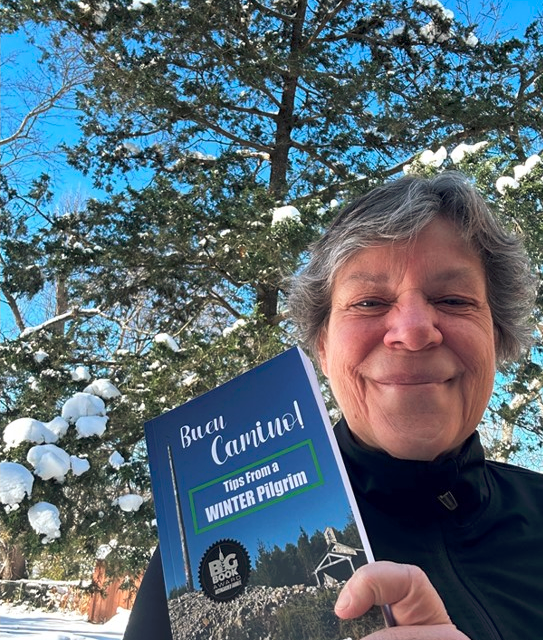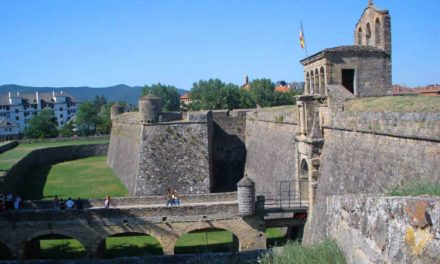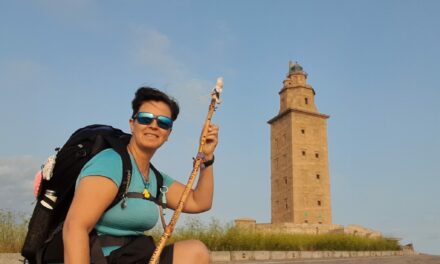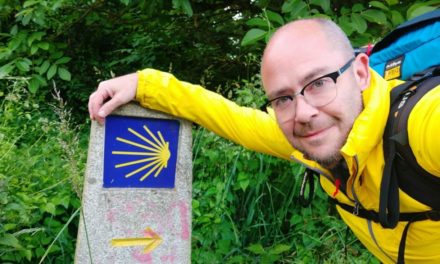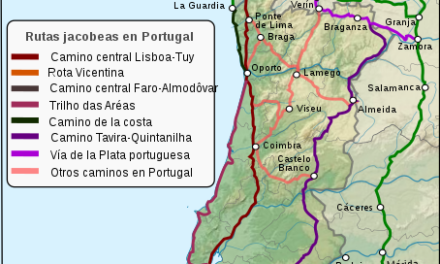Anne Born is the author of three books on the Camino de Santiago and, today, is one of the main connections between the United States and the Camino de Santiago. Poet, editor, historian… although for decades she lived in New York – from where she told us about the arrival of Covid-19 in her city and her country – today she lives in her native Michigan, from where she returns to the Camino once or twice every year, and continues to write, giving us new surprises with each book.
-Anne Born, three books on the Camino… But before talking about them, you already know that at the Fundación Jacobea we are very interested in people’s personal journeys, could you tell us a little about how you got to the Camino de Santiago?
It took me a very long while to get to the Camino. I smile when I think about it now. I was an undergraduate in the Art History department at the University of Michigan. I was fortunate to study with a prominent medievalist, Professor Ilene Forsyth, who taught a marvelous class in Romanesque Sculpture on the Pilgrimage Road. We covered the churches and cloisters in France mainly, her particular interest being the cloister at Moissac. I was captivated. I found her approach to be quite extraordinary, based on my somewhat limited expertise in medieval sculpture at the time. There was this road. A road that was traveled by poets, musicians, armies, and the artisans of the great cathedrals. And it was still there. And, with some effort on my part, I could see it myself. I could go there too. After all, she worked at Moissac.
I was a 19-year-old girl from a small town in Michigan, in an era when young girls, for the most part, did not pick up and hike across France and Spain. But that road stayed with me. In 2009, I enlisted my 18-year-old son to come with me and we visited Professor Forsyth’s cloister at Moissac and walked together across the Pyrenees into Spain. My first experience on the Camino.
I didn’t do very well. You could say I was a complete failure as a pilgrim on that first trip. But I came back the next year and picked up my very first Compostela on New Year’s Eve 2010 in the sacristy of the Cathedral in Santiago de Compostela; the pilgrim’s office was closed for the celebration of closing the Holy Door. I’ve walked eight more times and am very much at home now, both on the Camino and in Spain.
-Your first book -Buen Camino! Tips from an American Pilgrim- was specifically aimed at your compatriots: questions and answers about the Camino for Americans. Did you think it necessary to clarify many things to the Americans who come to the Camino? Have things changed in these years?
When I would tell my friends I was going for a very long walk across Spain because I had to get to this magnificent cathedral, the typical reply was, “I could never do that.” That bothered me. My friends said it was too far to walk, took too much time, cost too much, and was just too difficult for them to imagine doing it themselves. That really bothered me. “Aren’t you afraid you’ll get lost? Do you have to speak Spanish? Do you have to be gone for six weeks?” The bottom line with those questions was fear. It was scary. It was dangerous. I wrote the book to answer all that.
In my book, Buen Camino: Tips from an American Pilgrim, I write specifically to encourage Americans to pack up and go. If this is something that you’ve heard about, don’t be afraid to go. Fear kept me from going for decades, and I regret that. I was very nervous when I walked by myself in December 2010. I was sure I had taken the wrong bus from Madrid, that something awful was going to happen to me when I set out that first day in Sarria. I smile at that now too, because I remember arguing with the lady at the front desk of my hotel. She said, “Don’t leave now to start walking. It’s dark out.” I told her I would be just fine. That Saint James would be with me on my way. And I guess he was, because I got out of town and walked for a half hour in complete darkness, safe in the knowledge that I was on my way.
Have things changed? Yes, I think so. Americans can watch the movie, “The Way,” now. It makes walking seem like something anyone could do. It seems like a friendly journey that ends with a life-changing moment of clarity. It debuted in Spain the month before I arrived in 2010 – I didn’t see it until the following spring when it was out in Spain on DVD. The American Pilgrims on the Camino have active chapters now in many areas of the United States. They make such a positive difference both here in the U.S. and in Spain by sending American pilgrim volunteers to Spain, training hospitaleros, and by sending funds to help the albergues.
-Your love for the Camino extends as far as its ultimate goal: to the city of Santiago de Compostela and its cathedral, to which you dedicated your second book: ‘If You Stand Here: A Pilgrim’s Tour of the Cathedral of Santiago de Compostela.’ This is not an easy topic to investigate, and even less so from the US and in the midst of a pandemic! Tell us a bit about your motivation for writing this book and about the documentation and writing process.
When I volunteered in the Pilgrims Office in Santiago in 2014, I had free time to explore the city and the Cathedral. I ate very well, I have to say, and I found myself in the Cathedral every day for about three weeks. I would go in, take some pictures, light some candles, say a few prayers or attend Mass, and walk out wondering who all the people were who were buried there. I started focusing on the side chapels. I had this idea that I would get back to the U.S. and look up the names on each sarcophagus and learn who they were and why they were buried in just that place.
I had the idea to write a guidebook for me: as I was in the Cathedral in 2014. I wrote the book I wished I’d had then when I wanted to know so much about the people who had been in the church and the people who were buried there. I didn’t want to read one long Spanish name with a date after another long Spanish name with a date – I wanted to know their story. I wanted what no guidebook had given me: a long Spanish name, with a date and a story. How else would I remember who these people were?
It was the start of the pandemic in 2020 when I started writing in earnest. It was in so many ways a very scary time and a terrible moment in world history, but in another way, it was the perfect scenario for a serious writer – you cannot go anywhere, nobody can come over, all the fun things are closed, and everyone else is baking sourdough bread to take their minds off what was going on. I set up shop on my back porch so I could listen to the birds here in Michigan while I worked, and I started writing one story after another. My friends in Spain would write to me, “Did you get the story about so-and-so?” or “Did you talk to so-and-so about when this happened?” and I would send one email after another.
I started working in my local library, but when it closed in March 2020, I was fortunate to have access to the entire online Columbia University library system. I could read E-books, journal articles, and academic papers online. And because I was effectively outdoors on my porch, I would invite a friend over, masked and distanced, so I could tell her the stories to see if they made any sense. And ultimately to see if she would remember them. That was key.
The best part of my research was reaching out to scholars whose work I cited. I made such great connections and answered so many questions by just contacting the people whose work was so important and hoping they would reply to me. Very early on, thanks to Johnnie Walker Santiago, I was put directly in touch with the Technical Director of the Cathedral Museum, Ramón Yzquierdo Peiró. He is a brilliant art historian, and he quickly became my most valuable contact.
-Personally I think that your book on the cathedral of Santiago is no longer addressed to the American public, it is a jewel for anyone! I thought of your compatriot, the historian Arthur Kingsley Porter, essential in the recovery of the Camino in the 20th century, because I think you share the perspective that transatlantic distance gives you, which allows you to confront and synthesize an immense theme, because you dare to approach the cathedral completely and not superficially…
I have been fortunate to have sold copies of my book in seven different countries so far. I’d love to have a table opposite the entrance to the Cathedral. Get this book! It will tell you what you are looking at! It’s in English!
It was years ago, outside Notre Dame in Paris, when I watched tourists walk in. They would be in a long line that stretched across the plaza. Coming up to the doorway on the right side as you faced the façade, they would drop their gaze and shuffle in. I wanted to tell them they missed the best part: the tympanum over the doorway. It’s extraordinary.
I’m reminded of the opening to Kenneth Conant’s massive book on the Cathedral, published in 1926. “Struck by the meagre and inaccurate character of the graphic material on the church of Santiago, as compared with the wealth of literary source material and discussions, the writer determined to examine the building.” I think you could say I set out to do the opposite. There was a wealth of dry information available with colorful pictures, but no stories. One more superficial tour book was not going to make a big difference. I owned four guides to the Cathedral when I started writing – I had not gotten any further than page 12 in any of them. I find reading English translations from Spanish tedious. My guide was written by a native English speaker. I’m not sure there is another current guide to the Cathedral that is written in English by a native English speaker.
I like to think I am this generation’s response to Georgiana Goddard King who wrote so beautifully and convincingly about Spain in the 1920s. She wrote about the Camino and the Cathedral in the hopes of encouraging Americans to go there. And they did. I have had friends tell me they’ve gone to specific places in the Cathedral after reading my stories. I love that.
Visiting the Cathedral is ultimately the reason why pilgrims walk the Camino. It is ironic that it is the one piece of that puzzle that is so elusive. Pilgrims research routes, clothing, seasons, rainfall, and food – but then they will walk into the Cathedral and can only comment on how big it is.
-And so we come to your latest book: Buen Camino!: Tips From a Winter Pilgrim. Like the first, it addresses practical questions and resolves all kinds of doubts, but it is also a very personal book, because you are a pilgrim with great experience walking in winter, in December, January… What have you found on those pilgrimages? Why recommend pilgrimage in winter?
My first Compostela, my first walk from Sarria, was in December. Although I have walked in the so-called high season of April to October, there was something magical about walking in December that made a big impact. I loved walking for hours by myself. I loved how few pilgrims were in the albergues and pensions that I stayed in. I loved coming into a bar for a hot tea to warm up or finishing the day with a hot chocolate or a glass of red wine next to a fireplace. I had read that there are special blessings for those of us who walk in the winter months, but I’d do it again regardless.
In many ways, I hesitate to recommend people walk in the winter because I don’t want it to get popular! Someone told me it was a way to reconnect with the Camino Francés. That by walking in the winter without the crowds and the rush to secure a place for the night, you could experience the most popular route at an unpopular time and enjoy walking it again. I like that a lot.
I grew up in Michigan. I am used to six months of winter and I know how to dress, what to avoid, and in this case, how to pack. That’s the real motivation behind this latest book. I had a very different time in 2021 than I expected when I set out. And it’s not a memoir like you see with happy gatherings of a Camino family drinking a beer at the end of another day in the sunshine. I was honest – about my limitations, about the weather, and about what I learned. It surprised me that I was able to learn so much even now about hiking, about packing, and ultimately about staying warm. I wanted to share that.
-And to finish I would like to ask you about your current work and your future projects, as a pilgrim and as a writer…
I have two projects in the development stage. I want to write some of my family stories, not that anyone will read them. I’m doing this one for me. I have ancestors on the scene at key or pivotal moments in world history and I want to tell both that story and then how my ancestor fits in. One of my ancestors was sold into slavery in Barbados after the Monmouth Rebellion in England. Another was given her dowry by Louis XIV. I think these are interesting.
The second project relates to the Cathedral book – I want to write more of the stories, starting with a woman who in the 1460s raided the Cathedral Treasury to pay for the release of her son who was abducted as he came to Santiago to become the next archbishop. I think you want to know about her. There are lots of gifts in the Cathedral from visiting pilgrims – I want to research them as well.
I still write poetry off and on – I don’t think I’m very good at it, but I enjoy it. It clears my head.
I’d like to walk again as a pilgrim in January 2023 – we’ll see. I am debating between two routes – one from Villafranca del Bierzo where I left off walking in 2021, and the other from Ferrol, on the Camino Inglés. I think either would be splendid in January. I have family obligations over the holidays, but I may be off to walk after that. We’ll see!

